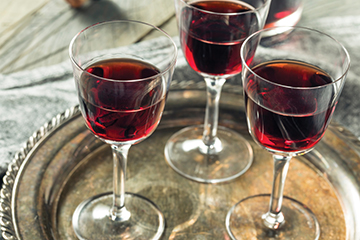
Well, in the olden days of fortified winemaking, potassium sorbate (a potassium salt of sorbic acid) wasn’t even a thing. While sorbic acid does occur naturally in some plants (rowan berries and hippophae berries, to be exact), almost all of the world’s potassium sorbate is made in a laboratory. In addition to potassium sorbate being a relatively modern, artificial ingredient, I also object to the aroma and taste of it in wine, which gives me fake pineapple and geranium vibes. Not so great. Luckily, there are some things you can do to ensure you get a completely arrested fermentation (and no re-fermentation) the next time you attempt your blackberry Port.
When making fortified wines, a must or juice is usually started just like normal, and then high-proof alcohol (like brandy) is gradually added in order to stop the fermentation. To make sure your wine gets really and truly “stuck,” I suggest employing these traditional basics: Fermentation kinetics management, temperature control, alcohol additions, sulfur dioxide additions, sugar additions, and, eventually at the end, filtration. (Note that these are the steps to producing a more traditional Port wine where little to no sugar is added to backsweeten, rather fermentation is halted in order to leave residual sugar from the original must/juice.)
• Non-robust fermentation: Under-pitch your yeast addition rate so that you don’t have a run-away fermentation that’s hard to arrest. Similarly, don’t over-feed your fermentation with yeast nutrients at the normal dry-wine level, since some of it will not be consumed when you add your alcohol to arrest the fermentation. Both of the above will help keep your fermentation moderate and easier to stop.
• Temperature control: By keeping your temperatures modest, you help ensure the fermentation won’t take off so quickly and, as such, will be easier to control and to stop when you do eventually add the alcohol. Ferment closer to the lower recommended temperature for your given strain.
• Alcohol addition: Indeed, the higher the alcohol, the less chance you’ll have of a refermentation. Most Port-style wines are over 18% alcohol, and to be safe, I’d aim for above 20% if your grape and wine style can handle the “heat.” You can fortify with a wide variety of spirits — because you’re not making your product to be sold commercially you have a lot of leeway. The traditional Port-style wine addition is brandy or grape spirits, often aged in oak. This remains a good choice but don’t turn down fruit-flavored spirits, unoaked spirits like grappa, or even a little Bourbon, if you’re hankering to make a Bourbon-barrel-aged type final product. No matter which spirit you use, be sure to do the algebra correctly . . . and don’t forget that “proof” is twice the alcohol content, i.e., an 80-proof spirit is 40% alcohol by volume.
• Sulfur dioxide addition: Yeast is sensitive (but not as sensitive as bacteria) to sulfur dioxide, so make sure a fortified wine has enough SO2. While it won’t kill yeast, it will inhibit them to a certain extent. Aim for bottling with free SO2 between 28–35 ppm for a reasonable balance between sensory quality (it won’t be too strong) and microbial abeyance.
• Optional “finishing sugar” addition: If the flavor profile of the wine and the wine’s balance warrants it, more sugar (in the form of table sugar, grape concentrate, etc.) can be added. The additional increase in osmotic pressure will further help retard yeast and bacteria growth.
• Optional filtration: Once the fermentation is stopped you will want to press, settle, and rack like normal. Be sure you keep measuring your Brix with a hydrometer (not a refractometer because the alcohol and any carbon dioxide bubbles will interfere) to make sure you’ve really stopped it. Once the wine is racked and has settled, sterile filtration is always a great technique to employ to make sure all microbes are excluded.
At the end of the day, if you really want to use potassium sorbate, you can add it at the rate of ½ teaspoon per gallon (3.8 L) of wine.





